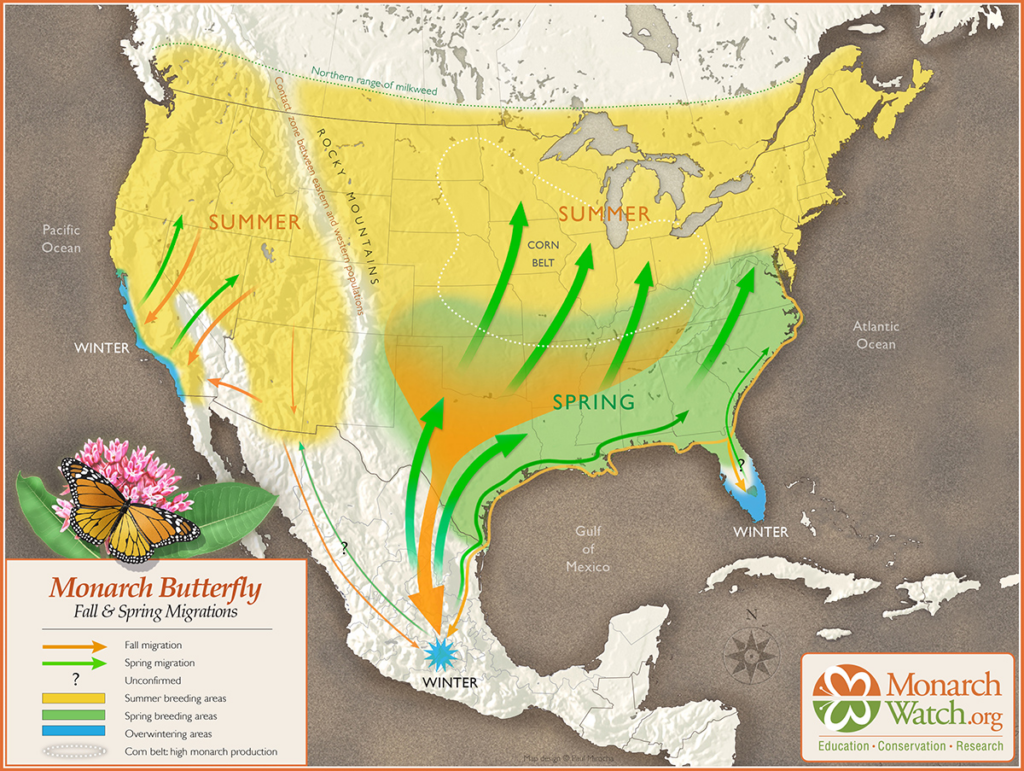With the eastern monarch butterfly population overwintering in Mexico reaching its second smallest size on record, the need for action is clear: we must rewild our gardens, parks, and communities. As the monarchs are making headlines, more attention than ever is being paid to the native plant movement.
The overwintering number counts for both eastern and western monarch butterflies have been lower this year, reflecting concerns for these populations. Eastern monarchs, migrating up to 3,000 miles to central Mexico, and western monarchs, heading to the California coast, both undergo significant journeys. And share the critical challenges of habitat loss, climate change, and reduced availability of milkweed and nectar sources along their migratory paths.

Eastern monarchs funnel from the East coast and Midwest toward Mexico, leveraging stopover sites rich in nectar and shelter to concentrate in a relatively small area in central Mexico’s mountains. They survive the winter in the oyamel fir trees (Abies religiosa). To support the long journey and overwintering period, the eastern monarch migration is marked by a change in the butterflies’ lifespan, from a few weeks to up to nine months. In contrast, western monarchs migrate a shorter distance to coastal California, occasionally extending into Baja California and Arizona. Western monarch overwintering sites encompass a range of tree species including eucalyptus (Eucalyptus spp.), Monterey pine (Pinus radiata), and Monterey cypress (Cupressus macrocarpa).
Eastern Migratory Monarchs
A recent report announced a 59.3% decline in total forest area occupied by overwintering colonies of eastern migratory monarch butterflies in Mexico – a mere 2.2 acres compared to 5.5 acres in last year’s survey. Furthermore, this winter season, researchers located only nine colonies of overwintering monarch butterflies, raising concerns about the decreasing size and increasing fragmentation of monarch populations.
The annual “Monarch Butterfly Overwintering Population Survey” is conducted by the World Wildlife Fund (WWF) Mexico, The National Commission of Protected Natural Areas in Mexico, the WWF-TELMEX Telcel Foundation Alliance, and other partners.

Western Monarch Count
This year, Xerces Society’s Western Monarch Count revealed a total of 233,394 butterflies across 256 overwintering sites. This count marks a slight decrease from the previous year but aligns closely with 2021 numbers. These data underscore the continued vulnerability of the western monarch population, which remains at just 5% of its historical size from the 1980s. Despite challenges, the count also highlighted positive engagement, with a record number of volunteers participating and several new overwintering sites identified.
Across their ranges, monarch declines have been attributed to factors such as habitat destruction, climate change, and pesticide use, highlighting the critical challenges facing monarchs. Conservation strategies are now more important than ever to support the recovery of this iconic species and ensure the sustainability of their migration.
In addition to the vial need to conserve monarch overwintering sites, Xerces offers these five actions you can take to secure a more hopeful future for monarchs:
- Plant native milkweed and nectar plants. Connect with your local Wild Ones chapter to learn which milkweed species grows well in your area and find out which species monarchs favor.
- Get involved locally. Join and support Wild Ones! At the local level, Wild Ones chapters offer a knowledgeable, hands-on, and supportive community. Take Xerces Pollinator Protection Pledge to commit to working every day to protect pollinators and their habitats.
- Avoid pesticides. Invertebrates are vitally important to a healthy environment, including controlling pests, pollinating flowering plants, and providing food for other wildlife. Reduce or avoid herbicide and insecticide use, especially systemic insecticides.
- Spread awareness. Share your knowledge and passion for monarch conservation with friends and family. Education is a powerful tool for change. Keep an eye out for newly developed monarch-related content coming to the Wild Ones members site this summer.
- Contribute to community science. Read more about community science programs you can make an impact in here: Community Science – Wild Ones: Native Plants, Natural Landscapes
By rewilding our surroundings with native plants, we each can play a pivotal role in reversing the tide for monarch butterflies. The news isn’t all bad: research from Iowa State University showed that adding milkweed and wildflowers to agricultural areas could increase monarch populations by 10-25% per generation. So keep planting and together we can make a difference for monarchs and the health of our planet.
